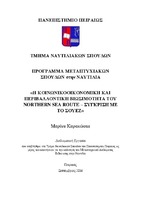Η κοινωνικοοικονομική και περιβαλλοντική βιωσιμότητα του Northern Sea Route – Σύγκριση με το Σουέζ

Keywords
Northern Sea Route ; Εξοικονόμηση κόστους ; Βιωσιμότητα ; Κλιματική αλλαγή ; Τήξη των πάγων ; Cost efficiency ; Viability ; Climate change ; Ice thawAbstract
Climate change has caused a variety of changes on the planet as a whole, as far as the
environment, the society and the economy is concerned. These changes can be also
seen in the Arctic, with the form of temperature increase and ice thaw. As a result,
there have been created new sea passages, that the last decades are being used by
ships. The most important of these routes is the Northern Sea route (NSR), and is said
to be the new sea bridge between Europe and Asia, replacing the traditional South
route and the Suez Canal, saving up to 40% distance between the two continents.
Comparing these two routes, it seems that Suez Canal Route offers more and better
facilities, and partial lower costs, such as the entrance fee and the insurance
premiums. However, NSR’s shorter distance and fuel saving cannot be neglected;
hence NSR is a tempting and promising new alternative. It should be predicted that
the transfer of the shipping volume in a virgin ocean, will harm the environment and
affect indigenous peoples, but will also be revolutionary for the shipping and transport
sector in general, and will connect people of the Arctic with the whole world. Today
only the seasonal use of the NSR seems to be the most profitable one in economic and
environmental terms, but more surveys need to be conducted to enhance the existing
knowledge.


